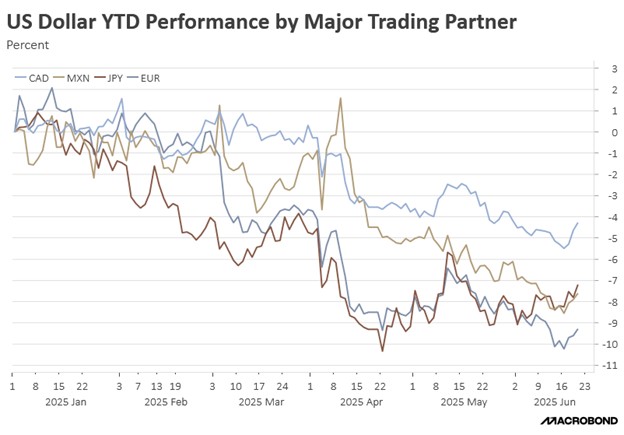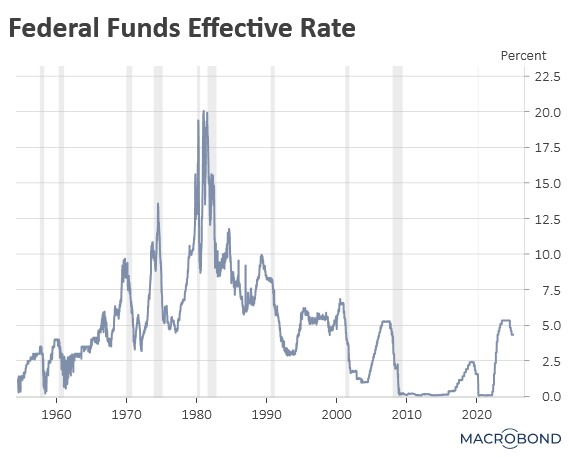Tag: Trump
Bi-Weekly Geopolitical Report – China’s Rising Power and the Implications for US Hegemony (October 27, 2025)
by Patrick Fearon-Hernandez, CFA | PDF
In a recent report, we noted that the world is now transitioning away from its 30-year era of Globalization, when the United States mostly embraced its traditional role as global hegemon, i.e., the big, dominant country that provides international security, ensures relative order, and issues the reserve currency. Our previous report showed that the world is now entering a new era of Global Fracturing or, potentially, Chinese Hegemony. In this report, we take a deeper dive into the current US-China balance of power. We show that in all key aspects of power — military, diplomatic, technological, and economic — the balance appears to be shifting noticeably in favor of China. As this monumental shift in international relations becomes more obvious, US leaders and voters are increasingly struggling to decide whether they want to cede hegemony to the Chinese, defend it, or reform it into something that is more “America First.” Whatever they decide, the US role as global hegemon is changing as China’s relative strength increases. We conclude our report by discussing the investment implications of this change.
Don’t miss our accompanying podcasts, available on our website and most podcast platforms: Apple | Spotify
Bi-Weekly Geopolitical Podcast – #72 “Tariff Trilemma: The Three Rs Driving US Trade Policy” (Posted 9/2/25)
Bi-Weekly Geopolitical Report – Tariff Trilemma: The Three Rs Driving US Trade Policy (August 25, 2025)
by Thomas Wash | PDF
Not all tariffs are created equal. Throughout the history of the United States, tariffs have been employed to achieve three primary objectives: (1) to pressure other governments into lowering their own trade barriers, (2) to generate revenue, and (3) to protect domestic industries. While ideally these goals would be achieved simultaneously, trade policy often presents a “trilemma,” where pursuing two of these objectives comes at the expense of the third.
This report explores the distinct types of tariffs, their impact on financial markets, and what recent trade developments indicate for the future of the American economy. As always, we wrap up with the implications for investors.
Don’t miss our accompanying podcasts, available on our website and most podcast platforms: Apple | Spotify
Asset Allocation Bi-Weekly – #143 “The Hidden Battle in the ‘One Big, Beautiful Bill'” (Posted 6/30/25)
Asset Allocation Bi-Weekly – The Hidden Battle in the “One Big, Beautiful Bill” (June 30, 2025)
by Thomas Wash | PDF
Tucked within the (ironically named) One Big, Beautiful Bill Act lies a provision that could dramatically reshape international capital flows. Section 899, colloquially termed the “revenge tax,” would empower the federal government to impose escalating taxes on the US passive income of individuals and corporations in countries with tax policies deemed discriminatory against American firms. This retaliatory tax, starting at 5% and potentially rising to 20%, represents a significant escalation in financial protectionism that could have far-reaching consequences for global markets.
Approximately $25.7 trillion in foreign-held US assets could potentially be affected. This includes $18.5 trillion in US equities (representing 20% of the market) and $7.2 trillion in Treasury securities (30% of the market). By taxing capital income going to foreigners, this provision risks weakening the demand for US Treasurys and could potentially trigger capital flight. The timing is particularly concerning as recent trade tensions have already sparked worries about the US dollar’s role as the global reserve currency. Substantial capital outflows could significantly increase the US’s borrowing costs and undermine the dollar’s global dominance.
The legislation specifically targets foreign policies that US lawmakers view as discriminatory, including the OECD’s two-pillar global tax framework (particularly its Undertaxed Profits Rule), various unilateral diverted profits taxes, and the EU’s Digital Services Tax. Washington considers these measures extraterritorial overreach that threatens US fiscal sovereignty while disproportionately harming American firms. The provision reflects populist concerns that foreign governments and supranational organizations are teaming up against US corporate interests in violation of established international norms.
Drawing inspiration from the reciprocal tariff measures unveiled in April, this legislation introduces a coercive framework that is designed to compel foreign governments to either rescind tax policies deemed discriminatory by the US or incur financial penalties. Republican lawmakers assert that certain OECD and eurozone tax initiatives fundamentally contravene core provisions of the Tax Cuts and Jobs Act (TCJA), thereby creating direct conflicts with America’s established international tax framework. Specifically, the conflicts in question are with (1) Global Intangible Low-Taxes Income’s (GILTI) anti-profit-shifting rules, (2) Base Erosion and Anti-Abuse Tax’s (BEAT) anti-base erosion protections, and (3) Foreign-Derived Intangible Income’s (FDII) innovation incentives. Consequently, the revenge tax functions as both a punitive instrument and a defensive mechanism.
If Section 899 is included in the final legislation, the US technology sector may emerge as a significant beneficiary. With major US tech firms deriving 40-60% of their revenue from overseas, the threat of retaliatory taxes could pressure foreign governments to reduce their own levies on American companies. This potential upside, however, must be weighed against broader market concerns such as weaker demand for US-denominated assets, which could push up Treasury yields and reduce the attractiveness of US equities. In turn, those developments could slow the economy and weigh further on the dollar, although one benefit would likely be a narrowing of the US trade deficit.
Senate negotiators are working to modify the most controversial elements of Section 899, including clarifying the status of Treasury securities and potentially lowering initial tax rates. But the administration’s track record of aggressive policy implementation has left many investors skeptical of verbal assurances. As the bill progresses, global markets will be watching closely to see whether this represents a strategic recalibration of US economic policy or a potentially destabilizing shift in international financial relations. The ultimate impact may depend on how foreign governments and investors respond to what could be interpreted as a new era of financial nationalism.
Don’t miss our accompanying podcasts, available on our website and most podcast platforms: Apple | Spotify
Asset Allocation Bi-Weekly – #140 “White House vs. The Fed: The Looming Battle for US Monetary Policy ” (Posted 5/19/25)
Asset Allocation Bi-Weekly – White House vs. The Fed: The Looming Battle for US Monetary Policy (May 19, 2025)
by Thomas Wash | PDF
The Federal Reserve’s independence faces its most serious challenge in decades as the Trump White House escalates its criticism of central bank policy. This brewing confrontation echoes historic tensions — most notably the 1951 clash between President Truman and Fed policymakers over yield caps that ultimately led to the Treasury-Fed Accord. Today, the battle lines are being redrawn as the administration pushes for more accommodative monetary policy while it looks to shield the economy from its own trade war.
The widening policy gap between the Fed and its global peers has been highlighted in recent months. While the European Central Bank, Bank of England, and the People’s Bank of China have all lowered their benchmark short-term interest rates to combat slowing growth, the Fed has held its benchmark rate steady — a decision repeatedly criticized by the White House. This policy divergence is further strained by the Fed’s quantitative tightening program, which Treasury Secretary Bessent argues complicates the issuance of longer-term government securities.
The debate has now moved beyond short-term policy disagreements to fundamental questions about the Fed’s role and independence. Former Fed Governor Kevin Warsh, widely seen as the leading candidate to replace Chair Powell when his term ends in 2026, has emerged as a vocal critic of the central bank’s current direction. His critique focuses on two key concerns: first, that the Fed has strayed beyond its core mandate by engaging in issues like climate change policy and diversity, equity, and inclusion; and second, that its operational approach — particularly the frequency of public commentary by FOMC members — has created unnecessary market uncertainty.
Market participants are closely watching several potential flashpoints. The administration has reportedly considered accelerating the leadership transition by nominating Powell’s successor well before his term concludes, a move that could allow markets to price in policy changes gradually. Warsh’s combination of Republican credentials, Fed experience, and Treasury background makes him the probable choice, although some investors question how his well-documented hawkish views might align with the administration’s apparent preference for easier monetary policy.
The stakes for investors are significant. Any perception of compromised Fed independence could trigger a reassessment of risk premiums across asset classes. Treasury yields may face upward pressure, particularly at the long end of the curve, while the dollar could weaken if markets question the central bank’s commitment to price stability. In other words, concerns about reduced Fed independence could exacerbate the budding US capital flight that we discussed in our recent Asset Allocation Bi-Weekly from May 5, 2025. Perhaps most critically, the Fed’s ability to serve as a stabilizing force during future economic downturns could be diminished if political considerations are seen to influence its decision making.
As this drama unfolds, market participants would be wise to monitor three key developments: the timing and nature of any leadership transition, changes to the Fed’s communication strategy, and, most importantly, whether the central bank can maintain its operational independence while navigating increasingly choppy political waters. The outcome of this power struggle will shape monetary policy and market dynamics for years to come.
Don’t miss our accompanying podcasts, available on our website and most podcast platforms: Apple | Spotify
Bi-Weekly Geopolitical Report – Growing Fragility in the US Bloc (April 7, 2025)
by Patrick Fearon-Hernandez, CFA | PDF
We at Confluence have written extensively on the end of post-Cold War globalization and the fracturing of the world into various geopolitical and economic blocs. We’ve noted that the large, rich bloc led by the United States is an attractive place for investors, but fractured supply chains and rising international tensions may produce a range of economic and financial market problems, from elevated consumer price inflation to higher and more volatile interest rates. In this report, we explore what could happen to the US bloc as President Trump pursues his aggressive policies to push the costs of Western security and prosperity onto the US’s traditional allies. As we’ve noted before, those policies run the risk of reducing US influence with its allies and undermining cohesion within the US bloc. We assess in this report that reduced cohesion probably won’t splinter the US bloc in the near term. Nevertheless, we begin laying out how the world could change if the US bloc does disintegrate, and we discuss the economic and market implications if it does.





